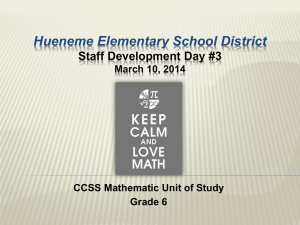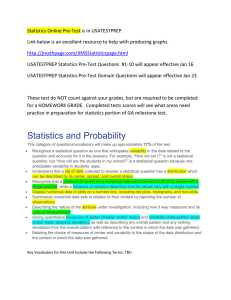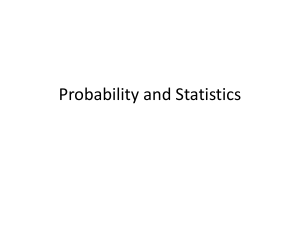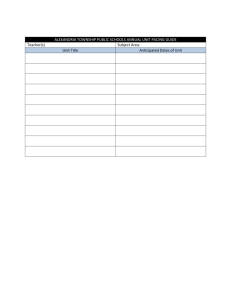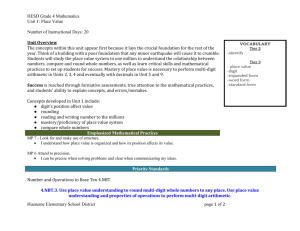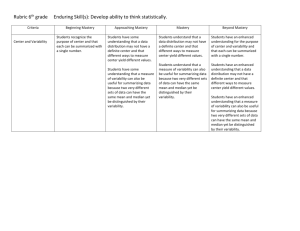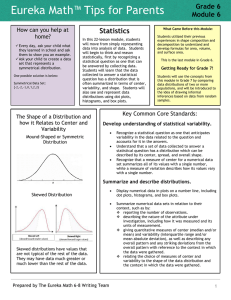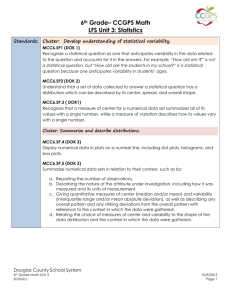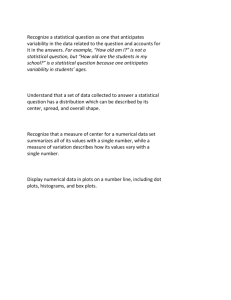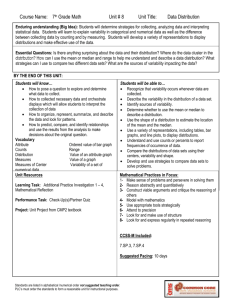Hueneme.Math.6thgrade.Unit6.Statistics
advertisement
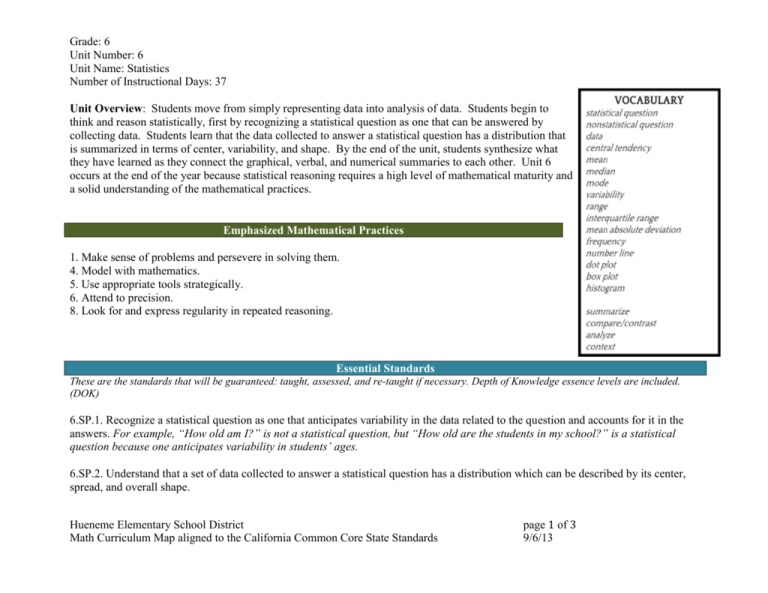
Grade: 6 Unit Number: 6 Unit Name: Statistics Number of Instructional Days: 37 Unit Overview: Students move from simply representing data into analysis of data. Students begin to think and reason statistically, first by recognizing a statistical question as one that can be answered by collecting data. Students learn that the data collected to answer a statistical question has a distribution that is summarized in terms of center, variability, and shape. By the end of the unit, students synthesize what they have learned as they connect the graphical, verbal, and numerical summaries to each other. Unit 6 occurs at the end of the year because statistical reasoning requires a high level of mathematical maturity and a solid understanding of the mathematical practices. Emphasized Mathematical Practices 1. Make sense of problems and persevere in solving them. 4. Model with mathematics. 5. Use appropriate tools strategically. 6. Attend to precision. 8. Look for and express regularity in repeated reasoning. Essential Standards These are the standards that will be guaranteed: taught, assessed, and re-taught if necessary. Depth of Knowledge essence levels are included. (DOK) 6.SP.1. Recognize a statistical question as one that anticipates variability in the data related to the question and accounts for it in the answers. For example, “How old am I?” is not a statistical question, but “How old are the students in my school?” is a statistical question because one anticipates variability in students’ ages. 6.SP.2. Understand that a set of data collected to answer a statistical question has a distribution which can be described by its center, spread, and overall shape. Hueneme Elementary School District Math Curriculum Map aligned to the California Common Core State Standards page 1 of 3 9/6/13 Grade: 6 Unit Number: 6 Unit Name: Statistics Number of Instructional Days: 37 6.SP.3. Recognize that a measure of center for a numerical data set summarizes all of its values with a single number, while a measure of variation describes how its values vary with a single number. 6.SP.4. Display numerical data in plots on a number line, including dot plots, histograms, and box plots. 6.SP.5. Summarize numerical data sets in relation to their context, such as by: a. Reporting the number of observations. b. Describing the nature of the attribute under investigation, including how it was measured and its units of measurement. c. Giving quantitative measures of center (median and/or mean) and variability (interquartile range and/or mean absolute deviation), as well as describing any overall pattern and any striking deviations from the overall pattern with reference to the context in which the data were gathered. d. Relating the choice of measures of center and variability to the shape of the data distribution and the context in which the data were gathered. Supporting Standards These are the standards that will be taught in conjunction with the Essential Standards, but they will not be commonly assessed (although some requirements from some may appear on rubrics). 6.NS.2. Fluently divide multi-digit numbers using the standard algorithm. 6.NS.3. Fluently add, subtract, multiply, and divide multi-digit decimals using the standard algorithm for each operation. Hueneme Elementary School District Math Curriculum Map aligned to the California Common Core State Standards page 2 of 3 9/6/13 Grade: 6 Unit Number: 6 Unit Name: Statistics Number of Instructional Days: 37 Enduring Understandings and Essential Questions for Content Standards Enduring Understandings are those concepts we want students to remember ten years from now. They are the important concepts underlying the content. The goal is that after instruction, students should be able to independently answer the Essential Question with a grade-appropriate version of the Enduring Understanding. Activities should be designed to allow the student to discover the Enduring Understanding Essential Questions are questions based on the Enduring Understandings that we use to guide or drive instruction and assessment. DATA COLLECTION: Some questions can be answered by collecting and analyzing data, and the question to be answered determines the data that needs to be collected and how best to collect it. ● What is a statistical question? How can a nonstatistical question be rewritten as a statistical question? ● How does the data collected relate to the context in which it was collected? DATA REPRESENTATION: Data can be represented visually using tables, charts, and graphs.The type of data determines the best choice of visual representation. ● When is one type of data display more appropriate than another? DATA DISTRIBUTION: There are special numerical measures that describe the center and spread of numerical data sets. ● How can data be summarized using measures of central tendency? ● How can data be summarized using measures of variability? ● What is the difference between measures of central tendency and measures of variability? Why are both important in describing data? ● How can data be described using measures of central tendency? ● How do you determine which measure of central tendency is most appropriate to use for a given data set? ● How are the measures of variability relevant to a given set of data? Hueneme Elementary School District Math Curriculum Map aligned to the California Common Core State Standards page 3 of 3 9/6/13
